Saturday, December 22, 2007
Highland Adventure
Journey to Chiang Rai - Chiangmai by Mystical Orient
by Mystical OrientNo rendezvous, just backpack, we reached there on a cool winter day. Chiang Rai, the gateway to Golden Triangle, is the mostly northern city of Thailand. Founded by King Mengrai in 1262, this city is a real attraction to visitors. It's a magnificent place, with strong cultural traditions. The rugged, hilly teak jungles which dominated the area remained into modern times, as have legends of secret magic and holy people born to save their people from dire events. Most things indeed remained as of old, up to just a generation ago.
Chiang Rai was the heart of Lana, though Chiang Mai, to its south, became its biggest city. To the west, some wild forest remains, in Mae Hong Son. North of Chiang Rai is the untamed Shan (or now perhaps better named Wa) State of Myanmar, and to the east, rustic northern Laos. The mighty river Mekong (Mae Nam Kong, in Thai) runs along the border, wide and strong, with commercial traffic and occasional boat races. It forms the Golden Triangle confluence where the small Sai, which marks the Mae Sai border, joins, flowing on south past Chiang Saen.
A nine hour journey from Bangkok can be made on air conditioned coaches originating from Mochit 2 Bus Terminal (02-936-3659). However, Think, our nice Thai friend, arranged a van for us to get there. Regardless 4 times stop on the way by a sleepy driver, the trip to Chiang Rai was wonderful. We departed from AIT at 9 pm and reached to the target around 8 am the next day.
 Think, our excellent trip organizer
Think, our excellent trip organizerIt was a wooden pillar house on the foot of a small hill. Think's sister's small house is not much different from other houses in the neighborhood. There are two bedrooms and a common place in the center for visitors. This house is about 15 km from the main road. We stayed there one night before moving to Chiang Mai on the next day.
 Ding, Think's brother in law
Ding, Think's brother in lawIn such a remote village like this, people go to bed quite early. Around 8 pm, doors closed and dogs stop barking. At 9 pm, we all got to bed like the other villagers. Night temperature was quite low, around 17 C. Everybody used thick blankets to survive over the night.


Back to the day time, after arriving and taking a rest in the village, we took a tour around the village. People in this area mainly live on agricultural activities such as rice cultivation, animal husbandry and orchard farming. A yellow harvested rice field with remaining straw shining under the sun looked so beautiful. Somewhere in the field, a group of farmers were finishing the late harvest work. When they saw us, everybody got a smile on their faces.










Our next destination was Doi Tung. It was really a hard trip for us sitting on a pickup's trunk facing the sunlight. Small pickup is popular in this hilly area, that's why we had no choice when no van was available. The two-hour journey finally finished with "blowing in the wind" hair and bloodless faces. Everybody was happy to put their steps on Doi Tung, a famous place which we used to hear about before.

Doi Tung Royal Villa and Mae Fah Luang Royal Gardens - the area's greatest pride. The temple here, built by King Achutarat of Yonok in 1911 BE, is considered the most sacred in Chiang Rai, and is a place of annual pilgrimage for many. It also continues to be held sacred to many in Shan State and the ancient Lan Sang area of Laos. On the Myanmar border, Doi Tung is the highest mountain in Chiang Rai, 2000 meters above sea level. Beautiful scenery and gardens, plus Akha and Lahu villages famous for weaving. Doi Tung Palace, on Doi Chang Moop, was the home of he late Princess Mother, who loved the Swiss Alps.












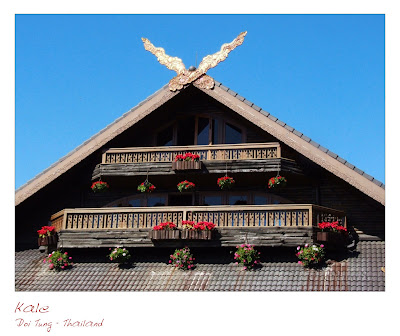








There was one special thing in Doi Tung, before entering all the common houses and restrooms, visitors had to take-off shoes or slippers. Restroom was not free, one had to pay 3 Baht each time of usage. Entrance fee to Doi Tung was also different between Thais and foreigners. Luckily, thanks to Think, we got local price for our tickets. I guess WTO's convention on one-priced policy does not work overthere. For students like us, keeping silence while passing the gate was money-saving and lots of fun as well.
The plan of making barbecue on the first day's afternoon was dismissed and replaced by another more exciting tour northwards. We headed to Mae Sai Town, an old town with busy commercial activities. There were lots of things from China and Myanmar. Needless to say, Chinese commodity always gives us a good feeling about its price. Perhaps, this makes the town one of the most exciting tourist attractions in the area. One can find it hard to deal with sellers when the real price used to be exaggerated. Bargaining tactics should be applied before putting your hand on the pocket. However, with a little Thai language knowledge, we could have a joyful tour around the market. My friend, Dung, of course didn't miss to buy a coat for the long journey back on the pickup when the night temperature fell.




We were back safely. So thankful to our pickup driver, who owns a small grocery, we could have warm water to shower. One by one enjoyed watching a quite latest movie - The Last Legion, while waiting for his turn to take shower at the grocery. Pirated DVDs from China are popular in the area.
The first dinner in Ding's house was delicious with sour pork/beef chop and spicy chicken soup. Men and women were supposed not to dine in the same table as tradition. Noisy discussion was prompted to avoid. Sigit, our Indonesian guy was lucky to have his islamic food. We savoured our food in hurry before the clock turned to 9 pm - sleeping time. The first night was so cold but nobody had any difficulty sleeping after a long tiring day.
Morning, wake up time was 6 am!
After a quick breakfast with dried beef/pork (moo-dat-diew, nua-dat-diew) and sticky rice (kao-nieu), we started to plan for the next trip.

The next destination is Nam Tok Khun Kon Forest Park. However, we did not get there directly. On our way, we passed by
The White Temple. Called officially the
Chapel of Wat Rong Khun it has become to be known simply as The White Temple. This is another one of those places that hasn’t been discovered by the Lonely Planet people yet. This is a modern form of architecture which you don’t often see in temple grounds. It was designed and built by Thailand’s premier artist Chaloemchai Khositphiphat. The attention to detail is remarkable and you do need to spend some time here studying the beautiful artwork. To reach the temple you have to cross a bridge over a pit of hell. Down below there are sculptures of people who are presumably trying to escape from hell. Inside the temple is a beautiful coloured mural of the Buddha.






Nam Tok Khun Kon Forest Park
Got a fame for its beauty, this waterfall located inside the jungle. Being aware of the previous trip with a pickup, we could manage to get a van to go there. This is the home of Chiang Rai's highest and most scenic waterfall, the Khun Kon, which cascades from a height of more than 70 meters. To get there, we took Highway 1, the Chiang Rai, to Phayao road, for 15 km and turned right at the park sign for another 17 km.
30-minute walk was not boring and tiring with sight seeing and tiny world discovery. We almost got our camera's memory card full before reaching to the waterfall.
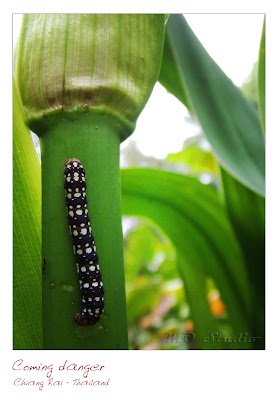


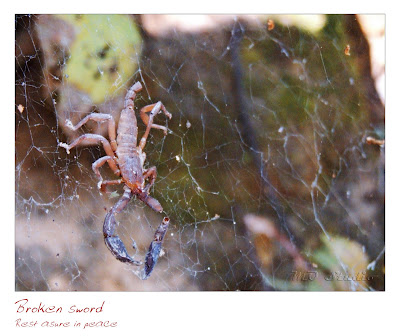




Over here, the waterfall was right in front of our eyes, so strong and beautiful.


and so peaceful as well

Back to Chiang Mai
In our plan, we passed Chiangmai but did not make any stop. Moving northwards and coming back on the other day was quite a good plan. As we had spent lots of energy for the Chiang Rai trip, little effort for Chiangmai on a van made everybody happy. We picked up a house from Think's old friend to stay overnight. It was a nice house with enough bedroom for all of us. On the next day, Tur, Think's friend, took us on his Isuzu around the city.
Our plan in Chiangmai was: Doi Pui --> H'mong Tribal Village --> Doi Suthep and dinner. Even though we could not enjoy the busy life of Chiangmai Night Bazar, a local night market famous for traditional handicraft and fine art stuff, we could successfully take a walk on one of the walking streets in the city. Most of things there were souvenir and gift stuff. Music, paintings, colorful dance and eye-catching performances along the street made the night so exciting. While others were busy shopping, Dung and I found a corner with traditional Thai foot massage service. One hour for foot massage costed 120 Baht (3.5 USD). If you have never tried before, I bet you would find it interesting and lots of fun. After it, we felt like walking on the cloud with very good feeling under our foot.



One day from Doi Tung to Mae Sai and back to Chiangmai with shopping life, everyone got exhausted and felt asleep immediately after taking a hot shower.
In the next morning, Tur came to pick us with his Isuzu to visit Doi Suthep. As an architecture with home interior design skill, he knew very well where to take us to enjoy the beauty of nature and historical places. We decided to take H'mong tribal village as the first stopping point.
Though it was commercialized for tourism, this place still featured many things which made us feel the atmosphere of a hilly tribal group. Several men, women and children colorful in traditional H'mong costumes created a very unique view for the village.


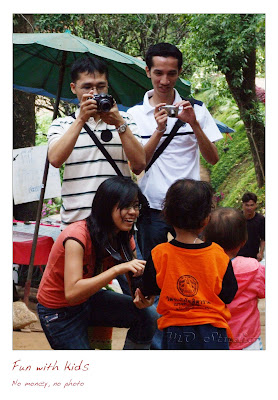





Opium production has been banned since 1959 and its production today has been virtually eliminated. However, we visitors still had chance to learn history through tools and pipe in the past exhibited over there. There was a part of the hill with some parcels of opium plantation for visitors to enjoy the beauty of this deadly plant.





Somewhere over there in the market, we could still find bee honey from opium flowers. Perhaps, this plant is still grown on the other side crossing the border in Myanmar.

Taking pictures with local people in traditional H'mong costumes costs 20 Bath. Nobody neglected to pay such an amount of money to have precious moment in a life time.



Sometimes, it was free to take picture with visitors in H'mong dress.








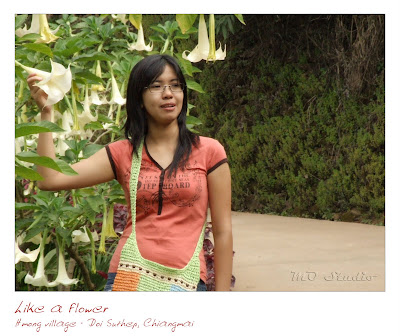









Running down the village about 2 km, we got to Doi Pui to enjoy the beautiful view of flowers and palaces.




The last point was Doi Suthep. We took a lift to the top of the hill with 20 Baht/each. Most of the tourists selected to climb up about 300 steps. The reward is more than worth the effort. You will see a beautiful Buddhist Temple and you will experience a beautiful view. While climbing the stairs, you should pay attention to the giant dragons on the sides of the stairs (they appear already downstairs; see the right hand side picture).
How was the spot for this Temple chosen? When the Temple was being planned, about 600 years ago, the Buddha relics, to put inside the Chedi of the Temple, were put on the back of an elephant. At the spot where this elephant would stop, the Temple was going to be built. The elephant stopped at the spot where the Temple has been built, which is not the top of the mountain, but roughly just halfway the mountain.





Over there, people could enjoy the view of the whole Chiangmai city. Even some monks could not help being surprised to the architecture of temple and stupa.


Don't take my words for it, just go and check it yourselves. I'm sure you will not regret.
Before leaving Chiangmai to Bangkok, we had a great dinner in Palad restaurant. It was a wonderful night with delicious food and live music.
 Posted by Mystical Orient
Posted by Mystical Orient
Can't see English? click here for Language Setting
0 Comments:
Subscribe to Post Comments [Atom]
---------------------------------------














































































































